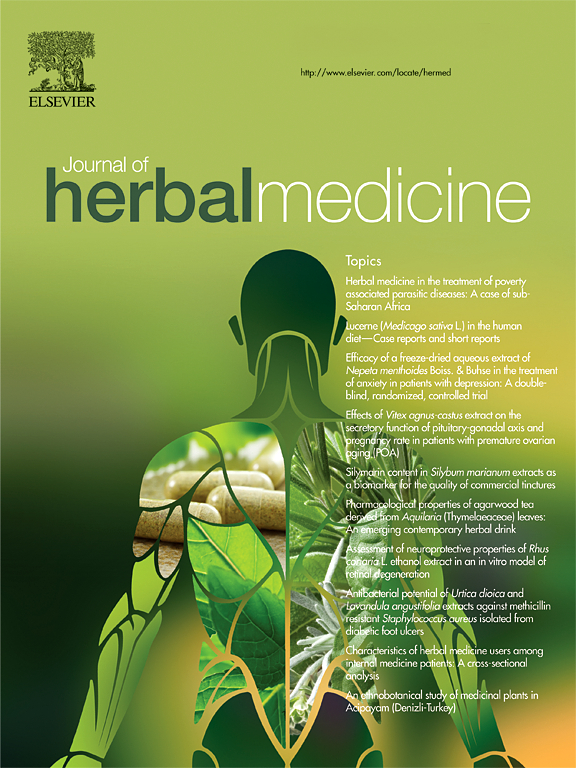通过网络药理学和分子动力学模拟研究温化水煎剂治疗非小细胞肺癌的机制
IF 2.2
4区 医学
Q2 INTEGRATIVE & COMPLEMENTARY MEDICINE
引用次数: 0
摘要
方法通过数据库收集文华煎剂的有效化学成分和靶点,筛选NSCLC的差异表达基因。以NSCLC差异表达基因和靶基因的交叉基因为种子,重新开始随机游走分析蛋白-蛋白相互作用网络。亲和力系数排名前50的基因被用于构建药物活性成分-基因相互作用网络。对网络中的核心靶点和相应的活性成分进行分子对接和分子动力学分析。槲皮素含量通过高效液相色谱法测定。定量实时聚合酶链反应(qRT-PCR)评估了CDK1在A549细胞中的表达。在 sh-CDK1 细胞中评估了文花煎对细胞周期的影响。结果药物活性成分-基因相互作用网络显示,CDK1是该网络的核心。槲皮素能与CDK1稳定结合,但不会引起蛋白质构象的显著变化。文华煎剂能明显降低 CDK1 的表达,阻止癌细胞从 G1 期向 S 期转化。槲皮素含量为 16.0 μg/g。结论 本研究揭示了文华水煎液治疗NSCLC的潜在靶点、活性成分和作用机制,为文华水煎液治疗NSCLC的临床应用提供了参考。本文章由计算机程序翻译,如有差异,请以英文原文为准。
The Mechanism of Wenhua Decoction in the Treatment of Non–Small Cell Lung Cancer by Network Pharmacology and Molecular Dynamics Simulation
Introduction
Network pharmacology approaches were applied to reveal the mechanism of Wenhua Decoction in non–small cell lung cancer (NSCLC) treatment.
Methods
Effective chemical constituents and targets of Wenhua Decoction were collected by database, and differentially expressed genes of NSCLC were screened. Restart random walk analysis for protein-protein interaction network was conducted using the intersected genes of differentially expressed genes and target genes in NSCLC as seeds. The top 50 genes in affinity coefficient were used to construct the drug-active constituent-gene interaction network. Molecular docking and molecular dynamic analyses were conducted for core targets and corresponding active constituents in the network. Quercetin content was determined by HPLC. Quantitative real time polymerase chain reaction (qRT-PCR) was performed to assess CDK1 expression in A549 cells. The effects of Wenhua Decoction on the cell cycle were evaluated in sh-CDK1 cells. Cellular thermal shift assay was utilised to examine the binding status between CDK1 and its target quercetin.
Results
The drug-active constituent-gene interaction network demonstrated that CDK1 was at the core of the network. Quercetin could bind to CDK1 stably while causing no significant changes in protein conformation. Wenhua Decoction treatment significantly reduced CDK1 expression and blocked transition of cancer cells from the G1 to the S phase. The quercetin content was 16.0 μg/g. Furthermore, cellular thermal shift assay experiment showed a high binding affinity between CDK1 and quercetin present in the Wenhua Decoction.
Conclusions
This study revealed potential targets, active constituents, and mechanism of Wenhua Decoction in treating NSCLC, providing a reference for clinical treatment of NSCLC with Wenhua Decoction.
求助全文
通过发布文献求助,成功后即可免费获取论文全文。
去求助
来源期刊

Journal of Herbal Medicine
INTEGRATIVE & COMPLEMENTARY MEDICINE-
CiteScore
3.90
自引率
0.00%
发文量
94
期刊介绍:
The Journal of Herbal Medicine, the official journal of the National Institute of Medical Herbalists, is a peer reviewed journal which aims to serve its readers as an authoritative resource on the profession and practice of herbal medicine. The content areas of the journal reflect the interests of Medical Herbalists and other health professionals interested in the clinical and professional application of botanical medicines. The objective is to strengthen the research and educational base of herbal medicine with research papers in the form of case studies, original research articles and reviews, monographs, clinical trials and relevant in vitro studies. It also publishes policy statements, opinion pieces, book reviews, conference proceedings and profession related information such as pharmacovigilance reports providing an information source for not only the Herbal Practitioner but any Health professional with an interest in phytotherapy.
 求助内容:
求助内容: 应助结果提醒方式:
应助结果提醒方式:


